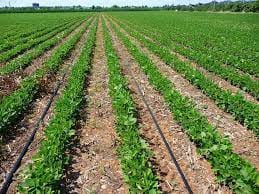Choosing the dripline is a key step in setting up an irrigation system. How many times has it happened to have drippers that dispense more water near the main pipe while dispensing less water at the final ends? How many times has it happened that during the harvest the quantities collected within the same field are not uniform? How often with minimum row lengths do you use a 20 dripline or even a pressure-compensating dripline?
In this article we will try to highlight some key concepts for the choice of dripline.
The choice of the dripline must always start from the water requirement that the crop requires, and therefore the liters per hour of the dripper, and from the type of soil which can determine both the distance between one dripper and another and both the flow rate of the same.
Then the size of the dripline is chosen, from 16 or 20 if rigid, and from 16 or 22 if we are talking about Tape or Hose. I hear many people choose a larger dripline thinking the emitters will deliver more water; completely wrong. The choice of dripline dimensions is determined on the basis of the maximum length of the rows and furthermore, to have an almost homogeneous uniformity, the working pressure must be 1 bar. This way you will have more or less homogeneous uniformity from start to finish.
I very often hear from people who work at high pressures thinking they have better delivery but this is incorrect. Most dripline manufacturers provide tables from which you can extrapolate the maximum distances that can be reached with each type of dripline.
Let's take an example to better understand the concept:
Let's consider two different types of driplines:
1) Light dripline of 16 with drippers distance of 30 cm and with a flow rate of 1.5 l/h at 1 bar of pressure;
2) Light dripline of 16 with drippers distance of 30 cm and with a flow rate of 0.8 l/h at 1 bar of pressure;
These two driplines have the same performance but simply change the distance at which it can be applied on the rows; with the first we will have a maximum reachable distance of 148 meters while with the second we will have a maximum distance of 180 meters. From this we can see that as the flow rate of the dripper increases, the maximum distance at which we can spread the dripline decreases.
If we worked with more pressure, let's assume 2 bar, the 0.8 l/h drippers would increase their flow rate up to 1.11 l/h and if we consider the reasoning made previously in this case with an increase in the working pressure and therefore an increase in the flow rate of the dripper, the maximum distance that can be reached would not be more than 180 meters but 155, therefore the crops present in the final part of the field will receive less water and therefore, probably, will give a lower yield.
The same thing applies to the dimensions of the chosen dripline which affect only and exclusively the reachable distance.
To understand this other concept let's consider two light driplines with the same characteristics:
1) 16 light dripline, distance of the drippers at 30 cm, flow rate 1.5 l/h;
2) 22 light dripline, distance of the drippers at 30 cm, flow rate 1.5 l/h;
In this case we have two driplines with the same characteristics but different dimensions; with the 16 dripline, as seen previously, we will have a maximum reachable distance of 148 meters while with a 22 dripline we will have a maximum distance of about 190 meters.
From this example it can be seen that the size of the pipe determines only and exclusively the maximum distance that can be reached. Therefore, in choosing the dripline it is necessary to consider, in addition to the factors described above, the maximum distance to which the irrigation system must be drawn.
The situation changes if we talk about "self-compensating" dripline. In this case the story changes. Let's start with the type of drip tray. When we talk about a self-compensating dripper we mean a dripper that has an internal membrane that compensates for the increase in pressure. So in this case there will be the same flow regardless of the pressure increase . Bearing this in mind, a self-compensating dripline must be taken into consideration when greater distances are to be reached and/or when there are particular situations of slope of the ground which do not allow uniformity of the emitters.

